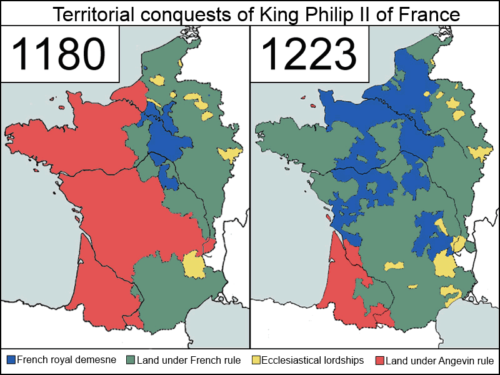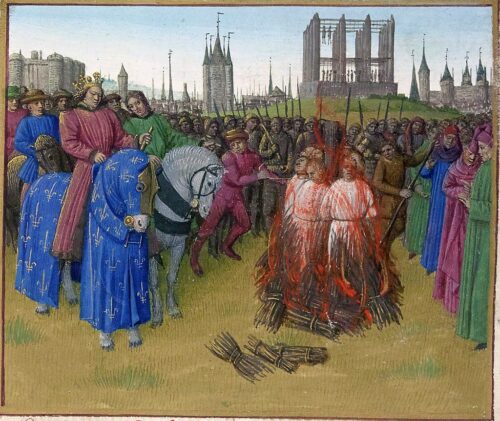Adolescence
In 987 a member of the Robertian dynasty that would become so strong as to change the name of the whole dynasty from Robertians to Capetians, Hugh Capet would jump from his position as Count of Paris to the French throne. The two most important cities of his personal domain were Paris and Orleans. Although the new king restored the Palais de la Cité which had stood in Roman foundations for almost a thousand years (on the site of the current Palais de Justice) he actually spent more time in Orleans. His son and successor Robert le Pieux however preferred Paris. He finished the restoration of the palace and turned it into his official residence and he also renovated the abbeys of Saint-Germain-des-Pres and Saint-Germain-l’Auxerrois which had lain in ruins since the first Viking raids.
Despite these shy steps of improvement, at the dawn of the new millennium Paris was nothing more than an unimpressive capital of an unimportant state, surrounded by hostile, richer and more powerful realms. When the Queen of Henry I (1031-60), Anne of Kiev came to live with her husband, she wrote to her father Yaroslav the Wise, that the place was “a barbarous country where the houses were gloomy, the churches ugly and the customs revolting”.


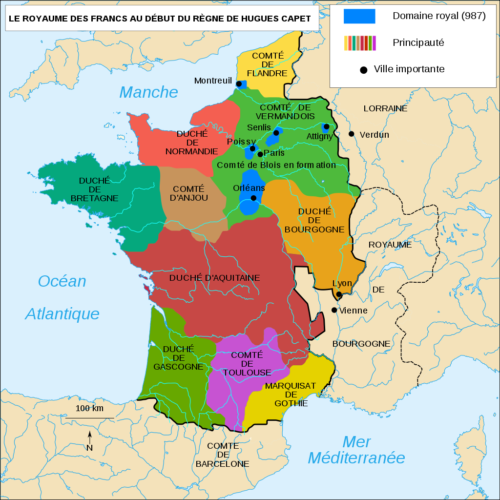
Up until the 1100’s the Capetian Kings struggled to keep their domain intact in an chaotic country of different languages and currencies controlled by powerful feudal lords. The constant infighting with the power-hungry vassals of the kingdom took its toll on the people of Paris who suffered from hunger. Consecutive waves of terrible famines were recorded during that century.
Things only started to take a different turn in 1108, when Louis VI the Fat ascented on the throne. Louis started to take on the robber barons that plagued the countryside with their hired swords. One after the other the obstacles of communication and commercial activity within the realm of the French king were removed and the economy was revitalized. In the same time the cathedral school of Notre-Dame (a few years before the building of the famous cathedral) started to attract gifted intellectuals of the time like Peter Abelard, a provocative philosopher, theologian, and preeminent logician who became master of the school and so famous for his lectures that hundreds of students from many different countries flocked to hear him teach on dialectic (logic).
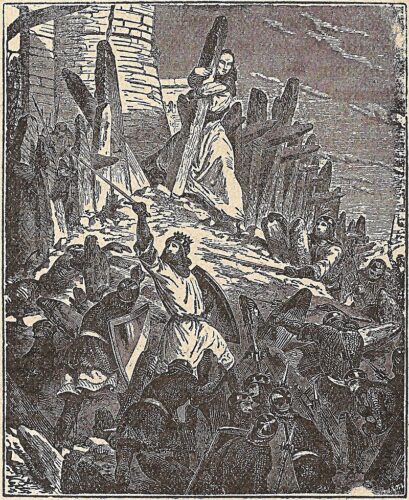
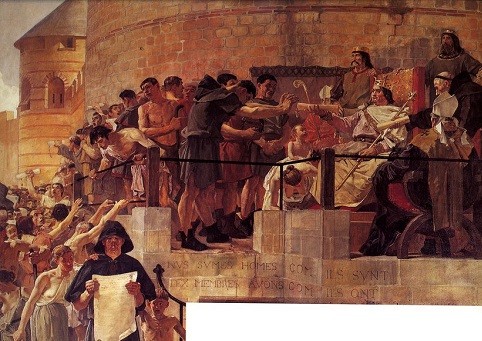
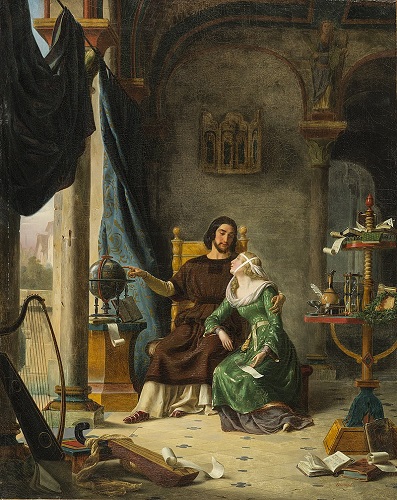
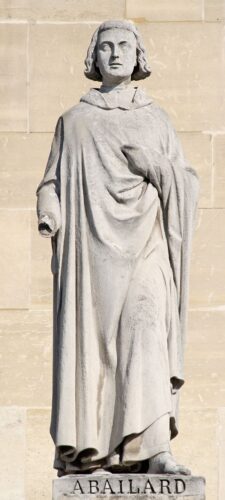
The third agent of change, was the head cleric of Saint-Denis. Abbot Suger (1122-51). In reality Suger was much more than an abbot. His influence extended to the highest ranks of the political sphere. He served for many years as the closest adviser of two kings, (the equivalent of the Prime Minister today) and he even served as regent between 1147 and 1149, when King Louis VII left for the second crusade. As a man who understood politics Suger was convinced that if the common people could not comprehend the Scriptures then they would surely be helped through images carved in stone or imprinted on a stained glass. He basically believed that modern churches should infuse an awe inspiring feeling with their design, their use of light and color. There were practical reasons of course that would support his decision for the reconstruction of the Carolingian Basilica of St Denis in a larger scale. The size of the existing church just wasn’t enough for all the faithful who wanted to enter, especially in times of great religious festivities.
In 1135 Suger’s personal taste, his ability to generate more funds from the privileges given to the abbey and his belief that worldly beauty was completely compatible with the love of God, would change the cultural history of Paris and the West as a whole for ever. In only 15 years after it had been conceived, an extraordinary achievement on its own, the first massive basilica of the kind Western Europeans would be very familiar with in the following years, had been completed. Its pointed arches, ribbed vaults, impressive stained glasses and irregular shapes would become the prototype for the Frankish style that would monopolize the architectural style of religious buildings for hundreds of years. It would later be widely known as Gothic style.
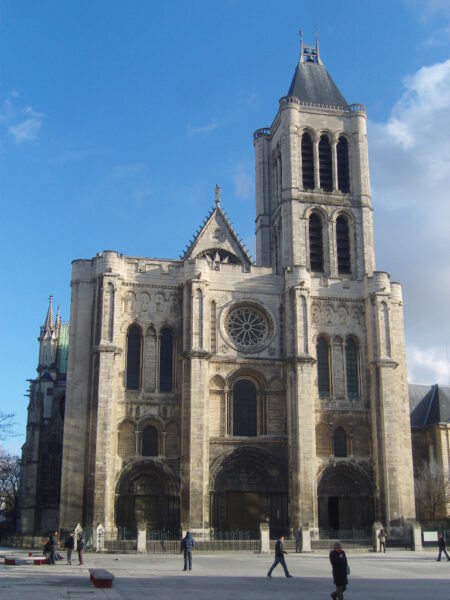
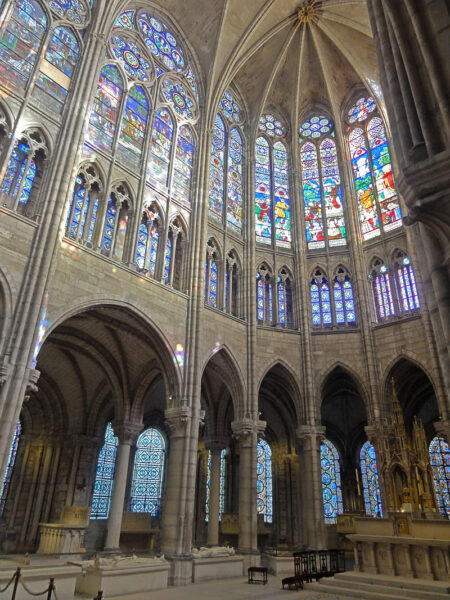
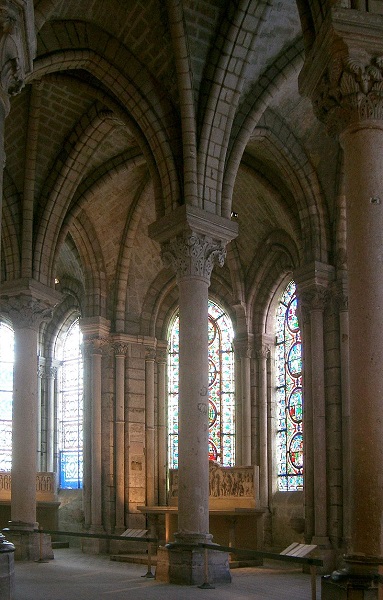
The population was on the rise (around 25.000 people in 1150) and the city spread from its nucleus on the Île de la Cité to the right bank (north of the river), where soon the majority of markets for meat, grain, fish, fruits etc. were placed, turning it into the commercial heart of medieval Paris. The Parisian merchants started to receive a special treatment from the king, who granted them the monopoly of all trade taking place across the Seine, at a range that stretched nearly 50 km from the city. The Parisian port was moved from ile de la Cite to the right bank of the Seine at a gravel beach close to the market square of Greve (where the Hôtel de Ville is located today). It soon became the main outlet of all Parisian trade routes. The economy entered a virtuous circle and two new fairs were established attracting merchants from all corners of Europe.
In 1163, the newly elected Bishop of Paris, Maurice de Sully decides to rebuild the Romanesque Cathedral of Saint-Etienne on the ’île de la Cité according to the contemporary Frankish style (Gothic), a proper reflection of the city’s royal status that could serve its growing population. The foundation stone of the new cathedral that was dedicated to Notre-Dame (Our Lady) was laid in the presence of King Louis VII, and Pope Alexander III. A great part of it would be completed by the time of Sully’s death in 1196.
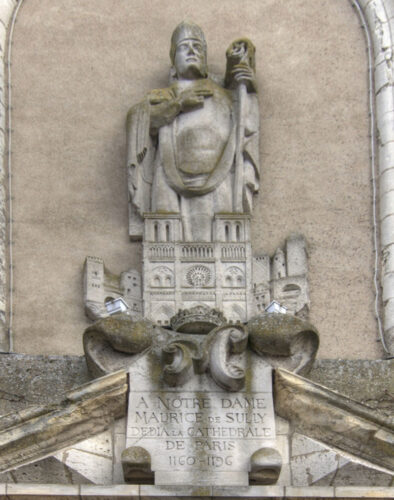
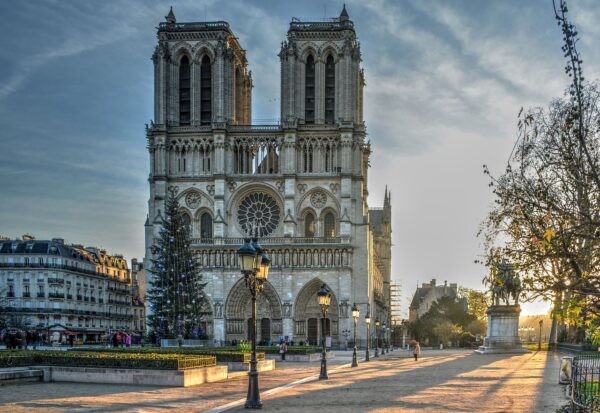
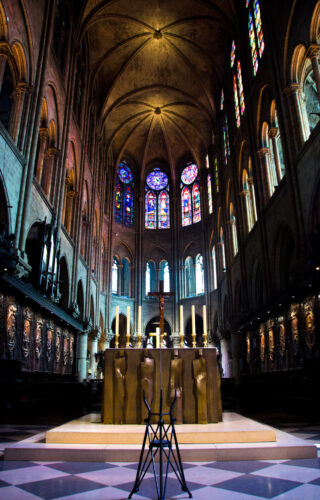
The next of the Capetians did not only reshape the fate of Paris but of the whole European continent as well. The fifteen year old Phillip II had to step up to the precarious French throne in 1180. In contrast to his father whose reign was considered to be an accident from the beginning, Phillip II had been raised to be a king and he had eagerly grown into his role from the very start. At the time of his coronation however the realm of his father had again been reduced into a tiny state, just a fraction of the surrounding French duchies and the Plantagenet Empire that stood both in English and in French soil.
Through a series of skillful moves and the fortune that came as dowry from his first marriage with Isabelle of Hainault, Phillip managed to expand his kingdom considerably both south and north in just five years. Also despite his constant movement across the different provinces of his realm, he immediately showed signs of a clear preference for Paris. By 1190 Phillip II had created a new roofed market (Les Halles) for the commerce of meat, bread and wine among others. He had paved the main roads of the city and had already started the construction of a new protective wall, that would encompass all parts of the medieval city and would make her truly impregnable for the first time in history.

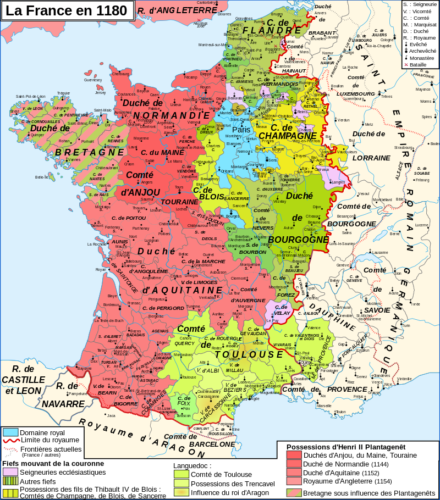
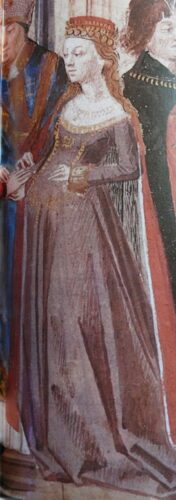
The news of Jerusalem‘s fall to Saladin led to the Third crusade. Philip II, could not repudiate a summons from the Pope. He reigned at a time when the papal bull could easily destroy a king. In the same time he was no fool. After a year of bloody warfare (1190-91) and the Conquest of Acre by the crusaders he decides to head back to Paris. His job at the Holy Land was over and the death of the Count of Flanders during the siege had created new opportunities back home. Philip II’s early departure along with his real politik scheme to keep his former comrade and fellow King Richard the Lionheart of England incarcerated in the prison of the German Emperor Henry VI would open up the first set of vicious wars between the French and the English, a prelude to the Hundred Years’ War of equal ferocity.


During the years of war between the two former comrades (1194-1199) two great projects progressed at full throttle in Paris. The first was the city wall and the second was a fortress, destined to evolve into the most famous museum in the world. The Fortress of the Louvre was being built on the west side, the side more vulnerable to the English attacks (some km away stood the English soldiers of Normandy). Just outside the new wall, the large castle with its wide moat, arrow silts and its ten defensive towers would be the first strong bridgehead of defense. The massive wall the second. In the same time the work in Notre Dame was also advancing in a slow but steady pace despite Bishop Sully’s death in 1196. The High Altar had been consecrated and the transepts were already complete. At the time of the war against Richard the Lionheart the nave was starting to take its shape.
The three projects were of course an enormous and costly endeavor that together with the expenses of a large scale war, were drying up the royal treasury. No doubt many people working in those projects or fighting in the king’s war could make their living but the rest were people dependent on trade. The ugly face of famine started to reappear in Paris while the battle with Richard’s army proved to be a disaster. Phillip was losing one battle after another. Just when Parisians thought it could not get any worse, three horrendous floods swept everything in their passage, including the two main bridges of Île de la Cité.
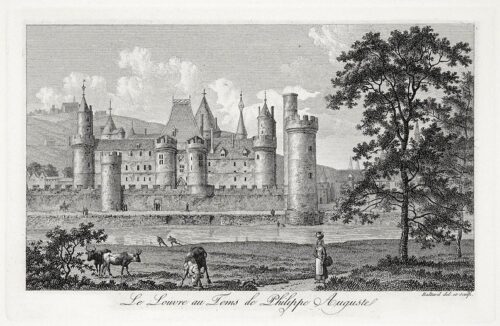
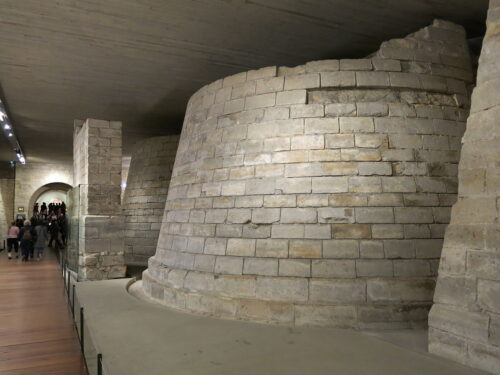

King Richard‘s death in 1199 gave Philip II a second chance and the French king would not let it pass by. In 15 years time he managed to win back all the lands conquered by the English king and gradually build up his army to the point that it would be possible to face any enemy on equal terms. In the most crucial battle of his eventful career, Philip II managed to triumph over an intimidating coalition between King John of England, Guillaume I of Holland, Ferrand of Flanders , Henry I of Brabant , Thiebaud I of Lorraine , Henry III of Limburg and last but not least the German Emperor Otto IV in the Battle of Bouvines on 27 July 1214. After that astounding victory Philip II would be forever known as Philip Augustus, an appellation given to him very early on by his chronicler but earned in the eyes of his subjects in that David-versus-Goliath-like battle at Bouvines.
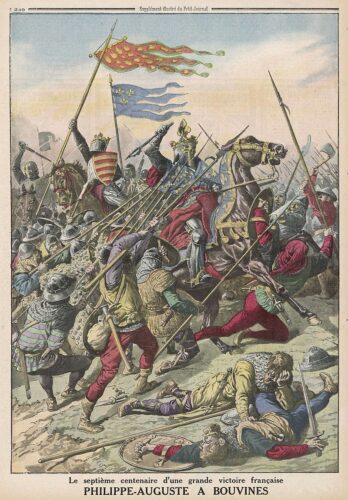

By the end of King Philip II‘s term in 1223, Paris had become the strong and undisputed capital of a powerful French kingdom. A fortified city protected by a massive defensive wall that due to Philip’s success was nothing more than a demarcation luxury. It was also a city that offered its merchants a well-placed site on the right bank of the Seine, where both goods and vendors could be protected from bad weather and robbery. By establishing Les Halles Philip set the foundations for Paris as a major trading center of Europe. Paris was also a place where the university, officially chartered after year 1200, was an autonomous borough, completely independent from royal jurisdiction. Its teachers and students protected by law. Many of the students were foreign. They followed its reputation as a renowned place of liberal teachings that came after the time of Abelard and its separation from the Cathedral school. Some 20.000 students attended at the university at the time of Philip’s death with a great part of them being German, Italian and English. A whole new district, the Latin quarter would be named by the language of teaching of these students. Three new districts, Saint Honore, Saints Peres and Les Mathurins, named after the new churches and monasteries built to serve their people, three new hospitals, new aqueducts, the first since the Roman era, numerous new fountains and paved roads, all together with the booming bourgeois class and the draconian law and order of Philip II had transformed the once struggling Capetian capital into a leading capital of the West in less than fifty years.
